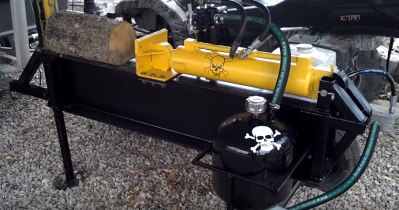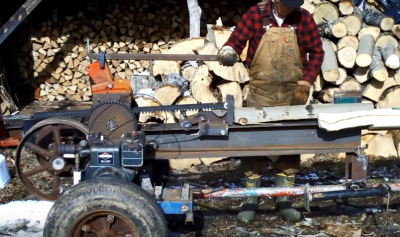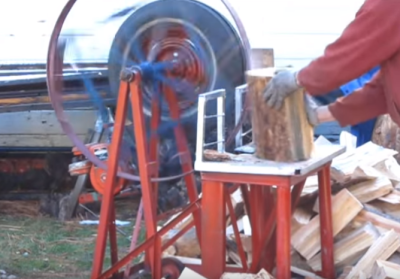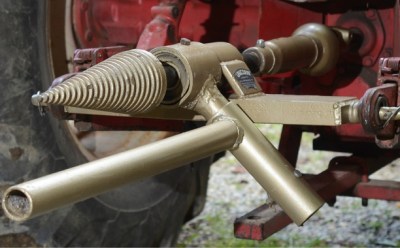Wood. Humans have burned it for to heat their homes for thousands of years. It’s truly a renewable source of energy. While it may not be the most efficient or green method to warm a space, it definitely gets the job done. Many homes still have a fireplace or wood burning stove for supplemental heat. For those in colder climates, wood is more than just supplemental, it’s needed simply for survival.

The problem with firewood is that it doesn’t come ready to burn. Perfect fireplace sized chunks don’t grow on trees after all. The trees have to be cut up into logs. The logs must be split. The split wood then needs to dry for 6 months or so.
Anyone who’s spent time manually splitting wood can tell you it’s back breaking work. Swinging an 8 pound maul for a few hours will leave your hands numb and your shoulders aching. It’s the kind of work that leaves the mind free to wander a bit. The hacker’s mind will always wander toward a better way to get the job done. Curiously we haven’t seen too many log splitting hacks here on the blog. [KH4] built an incredible cross bladed axe back in 2015, but that’s about it.
There are a ton of commercial firewood splitters out there. For every commercial model, there are hackers designing, bolting, and welding their own splitters. Many of these homemade devices find their way to the internet. As you probably can imagine, ideas and implementations range from high tech to redneck.
Wood Meets Pressurized Oil
 The most common powered log splitter is a hydraulic design. These are the same types of splitters you might see for sale at your local big box home center. A steel I-beam, hydraulic cylinder, gas engine, and a pump are the basic building blocks of a splitter like this. Think of it as a horizontal version of the machine used in the hydraulic press channel. The cylinder moves a push block, which shoves the log into a wedge. A great example of a home built hydraulic splitter can be found on [Smalls4068’s] YouTube channel.
The most common powered log splitter is a hydraulic design. These are the same types of splitters you might see for sale at your local big box home center. A steel I-beam, hydraulic cylinder, gas engine, and a pump are the basic building blocks of a splitter like this. Think of it as a horizontal version of the machine used in the hydraulic press channel. The cylinder moves a push block, which shoves the log into a wedge. A great example of a home built hydraulic splitter can be found on [Smalls4068’s] YouTube channel.
Hydraulic splitters get work done faster than manual splitting, but you still have to wait for the cylinder to retract. [Ricky Cupp’s] built himself a two way splitter. The wedge is mounted in the center in this system. The push block can then push (or pull) a log into the wedge from either side. If simply splitting a log in two isn’t enough for you, check out [1D10CRACY]. His machine can cut a large log into four chunks at a time. More splits require more force though, which means larger cylinders and bigger engines.
Wood Meets Spinning Wheel (of Doom)
 Some folks have a need for more speed. The hydraulics used in log splitters aren’t exactly fast devices. Kinetic splitters are the solution here. Kinetic splitters use a small engine to spin up a flywheel. When the splitter is activated, the flywheel’s pinion gear is engaged with a rack. The rack pushes the wood into the wedge. Sounds complex, but [Gary Gilmore] does a great job of explaining his design in this video. The flywheel on his splitter began life as part of a bulldozer diesel engine. 75 lbs of steel spinning at several hundred RPM generates quite a bit of force!
Some folks have a need for more speed. The hydraulics used in log splitters aren’t exactly fast devices. Kinetic splitters are the solution here. Kinetic splitters use a small engine to spin up a flywheel. When the splitter is activated, the flywheel’s pinion gear is engaged with a rack. The rack pushes the wood into the wedge. Sounds complex, but [Gary Gilmore] does a great job of explaining his design in this video. The flywheel on his splitter began life as part of a bulldozer diesel engine. 75 lbs of steel spinning at several hundred RPM generates quite a bit of force!
 Then we come to a class of log splitters where common sense exits stage left. These are flywheel splitters, sometimes called widowmakers. The winner for scariest machine we’ve seen this week goes to [Jack Dickson] and his creation “The Wheel of Debt” [Jack] turned a pile of steel scrap into a device which makes us cringe just watching it. An 8 pound maul head is welded to a built up steel wheel. The wheel is spun by a small engine through a belt and car tire arrangement. The relatively lightweight wheel must spin quickly to generate enough force to split logs. This video was Jack’s last upload, so we can only assume his creation eventually got him. ‘
Then we come to a class of log splitters where common sense exits stage left. These are flywheel splitters, sometimes called widowmakers. The winner for scariest machine we’ve seen this week goes to [Jack Dickson] and his creation “The Wheel of Debt” [Jack] turned a pile of steel scrap into a device which makes us cringe just watching it. An 8 pound maul head is welded to a built up steel wheel. The wheel is spun by a small engine through a belt and car tire arrangement. The relatively lightweight wheel must spin quickly to generate enough force to split logs. This video was Jack’s last upload, so we can only assume his creation eventually got him. ‘
Wood Meets Pointy Metal
There are other versions of the widowmaker out there. Those with heavier, slower spinning wheels manage to do the job with less drama, but accidents are just around the corner.
 One final type of log splitter is the rotary splitter, also known by the brand name Unicorn. These splitters use a threaded rotating cone to drill into the log and split it apart. Sounds a bit dangerous, right? A commercial version called The Stickler is still available. The Stickler is designed for rear wheel drive vehicles. That didn’t stop [Mikelbonilla78] from hacking his ‘92 Honda Civic into a stationary log splitter. He even added an exterior throttle and emergency battery disconnect. Even with these safety features, we’re going to go ahead and say this one is scary.
One final type of log splitter is the rotary splitter, also known by the brand name Unicorn. These splitters use a threaded rotating cone to drill into the log and split it apart. Sounds a bit dangerous, right? A commercial version called The Stickler is still available. The Stickler is designed for rear wheel drive vehicles. That didn’t stop [Mikelbonilla78] from hacking his ‘92 Honda Civic into a stationary log splitter. He even added an exterior throttle and emergency battery disconnect. Even with these safety features, we’re going to go ahead and say this one is scary.
So we turn the question over to you, our fine readers. Those who do have the unhappy task of splitting wood, what hacks have you come up with to make the job easier?
















What I do:
Use a “wood grenade” (4-sided/cone-like splitting wedge) with a sledgehammer to crack the round into half or more. Have another wedge or 2 handy in case it gets stuck in a difficult round.
Then set the half-round splits on a platform (old tree stump in my case) with an old tire big enough to contain the split/round, and slice off decent splits with a 6lb maul.
Great workout and makes the job doable by hand.
And then there’s the powder wedge for a true ‘wood grenade’.
https://www.youtube.com/watch?v=AkcsJUQG4cI#t=1m07s
Knew a farmer that when he was a kid his dad was just starting the farm. Farm land started off as old growth forest, so the dad had someone come and log the property, but they left the stumps. He then ran into a whole lot of cheap dynamite. So he gave his kid and a few of his kids buddies (none were more than 10 or 12) the dynamite and told them go blow the stumps out of the ground, and that 1/4 stick a stump oughta do it, but don’t use more than 1/2 a stick. Surprisingly all the kids survived without injuries and the field is stump free to this day.
I thought I found every crazy method for splitting wood on youtube. You Sir, win 1 internet today :)
I cannot believe I have never seen a wood grenade before…very cool!
Chopping wood is about simple forces. Don’t over-complicate it, just get a better axe
https://youtu.be/E9_9wmjK3j8
http://www.core77.com/posts/26852/Your-Facebook-Friends-Were-Right-This-Axe-IS-Amazing
Many reviews complain it’s just a gimmick and the axe itself is too light to do anything on tougher wood, and/or hurts your hands on the recoil. They all seem to conclude that an ordinary axe that doesn’t cost €200 does the job equally well.
If you’ve got time on your hands Coppicing saves you the effort of splitting.
An acre or so of fast growing trees (Hazel, black locust) should keep a single family home fairly comfortable in most temperate climates if coppiced.
How does letting a tree grow from an cut back stump help split wood?
Coppiced or Pollarded stumps produce a number of growth shoots. These shoots grow back fairly straight with minimal intervention. As for how this helps save splitting wood. That all depends on when you harvest them.
If you harvest the stump 1-3 years after the initial cut you’ll have thin canes suitable for wicker work or fence hurdle making. If you harvest the stool 5-10 years after the initial cut, you’re left with 3-5″ diameter sized wood, which for most heating uses does not require splitting.
Harvest times depend on tree species & desired use. Birch, Hazel, Poplar, Linden, Locust, all grow pretty fast. With these it may be possible to harvest a winters worth of firewood that doesn’t need split, every 3 years. Depending on climate & growth conditions.
I believe the pinical of log splitting is this: https://www.youtube.com/watch?v=X0-1Rx1NNDY
That operator is fantastic. When he picks up the second log with the cat you can see him bouncing it up and down just like you might with your own two arms to center the weight.
On second look, that’s probably just the oscillation of the tires/suspension and the fast motion makes it look different. Still, great machine!
Burning wood IS the most green fuel (as opposed to fossil fuel) because it is carbon-neutral. The carbon in wood came from the atmosphere in the first place, whereas propane and natural gas come from underground (carbon-positive).
Green is more than just carbon footprint. The issue is the fine particulate emissions, which are incredibly high for wood burning appliances vs dinosaur fuels.
True, we should ban trees, they release volatile organic compounds in hot sunlight that are a prime culprit in photochemical smogs.
That is not true for modern efficient boilers/fireplace inserts that are operated properly with dry wood. There are even units with catalyzer.
On the other hand, it produces particulate matter equal to second hand smoking in the neighborhoods where people heat with wood, and the collecting/farming/forestry consumes fossil fuels, and cutting down forests speeds up the CO2 cycle which keeps more of it in the atmosphere and slows down natural carbon sequestering processes by not allowing the wood to break down and become soil.
The greenest fuel would be burning agricultural waste cellulose in a pyrolysis process where the remaining charcoal and ash are tilled back into the fields to recover the nutrients. It’s called terra preta, and it is carbon negative source of energy that improves soils.
It’s also been discovered to be the reason much of the jungle in South America grows so well. It didn’t used to be there until the civilizations declined. The jungle is growing on fertilizer put in the ground by humans.
Aside from particulate emissions there is deforestration problem in many region of the world because too many cut trees faster than they can grow.
Hand tools are great for splitting hardwood. You really appreciate the powered ones when you encounter sweetgum. The wood fibers are intertwined and it generally doesn’t split, it has to be forced apart by driving a hydraulic ram most of the way through the log!
BTW, it’s lousy firewood, but you burn what you can get.
Ah, the reggies…
wait… SPLITTING!? Uh, wrong forum, my bad.
I feel we’re unnecessarily rejecting the opportunity to solve the problem with the application of thermite…
Freaking splosives! THAT is how you make quick work of cutting wood. You tube for examples and automatic inclusion on some alphabet soup agencies black lists.
Well yeah if you can get C4, that works. I was thinking you could knock an ice wedge in the end, put a small pile of thermite over it and have it explode into superheated steam throwing gobs of molten iron everywhere (Which would look really cool filmed in the dark with the IR filter off.) … so some form of eye protection would be wise, like those raybans you don’t wear any more because of the scratch.
Oh my God. That Wheel of Debt.
Just watching him gingerly shove logs in the direction of the rotating axe head of death, and then trying to get his fingers away ASAP… what the actual fuck.
I cringe when I watch those videos. “I would recommend a kickback shield” he says. No sht. I would also recommend “trip over and fall onto the axe wheel” shield.
Here’s a fun one-
https://m.youtube.com/watch?v=IAddyGNZ1cQ
I wish I could find a video. I remember as a kid seeing a round baler made into a splitter, it would take 8′ lengths and chain conveyor them and buck them down to 18″ or so, then the cut pieces would fall into a basket a guy would grab from and use a axe head wheel of death to split them, he would toss them onto another chain conveyor that would take them up to a drop into a pile or into a truck. It was mesmerizing. The trouble with hydrolics is that they’re typically so slow…
You know that machine looks like it could be a lot more efficient, and safe, if it had an attachable “log magazine”, load in half a dozen logs and let’er rip.
that machine almost looks like a good idea – until he starts wrestling with that one big log…
the “widow maker” is arguably much safer then the “wheel of debt”, since it doesn’t bounce around and the maul moves slower.
brrrr https://www.youtube.com/watch?v=40sCGb678sQ
I’m quite impressed by this one. It’s rather well made.
You might still point out the lack of protections but they are aware of the risks and handle the logs properly (placed like that the knockback is highly reduced), making it averagely safe.
However, you’re the second video is 100% unsafe. The operator is not handling properly and you can see logs flying at him. Best case scenario on a long time use would be a wrecked hand while the worst case could be a log sent in chest or face at full speed.
But wait there’s more (and worse) https://www.youtube.com/watch?v=3TnPAGyx12Y
I’d like to put up a video but I think its best keep it off the internet. I heard though, that you can take some tannerite and build yourself a little shape charge to set off the log you’d like to slit. Splitting wood from 200 yards away has never been so much fun! 1 shot, 8 equally split pieces of wood! Bonus point for falling the tree with tannerite. Just make a small square bore hole with your chain saw first! It may not be the most efficient, but damn it might just be the most fun.
Here’s the best splitter:
https://www.youtube.com/watch?v=_ORDJ-7dZG8
No mention of the Fiskars X27 splitting axe. The best value out there!
https://www.youtube.com/watch?v=i5z3DXCNW_I
Holy shit. Fiskars makes AXES too?
Available in every big-box home store in Germany…
Keep in mind, constructing content for your individuals will certainly result in much better results than trying to develop web pages for internet search engine.
awesome article.Fiskars X27 splitting axe my favourite